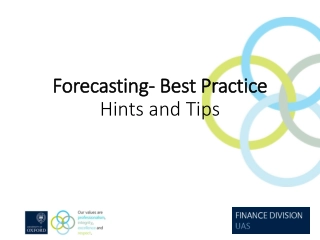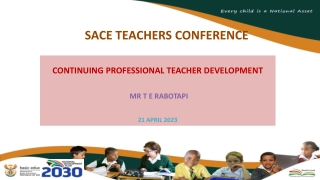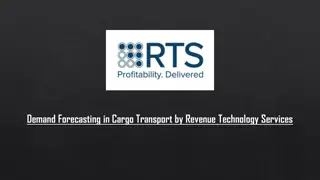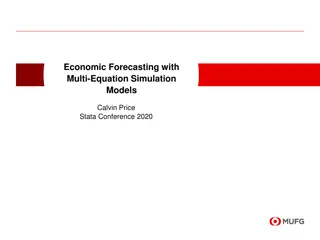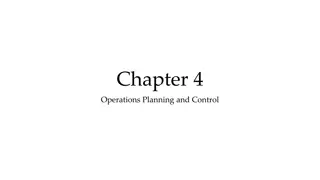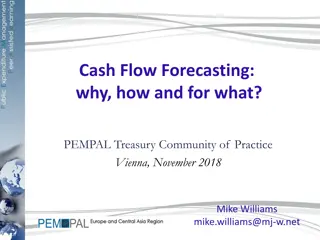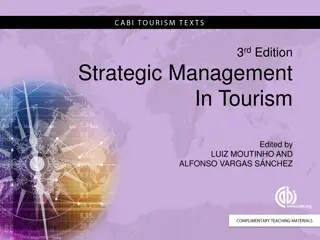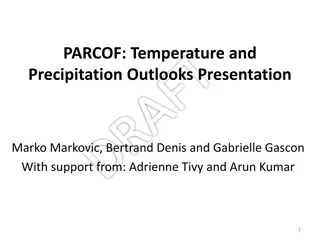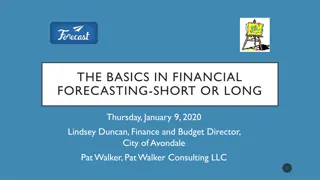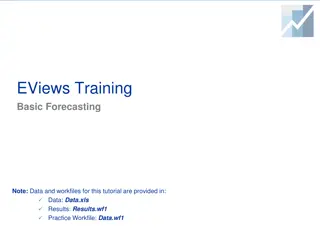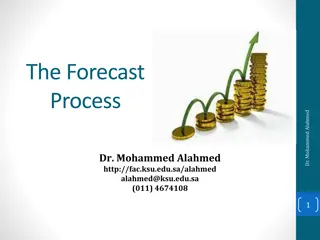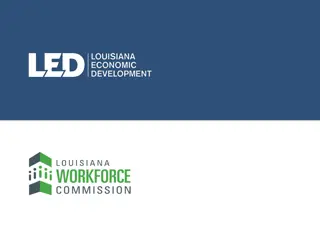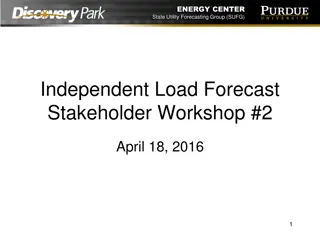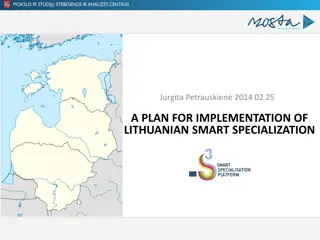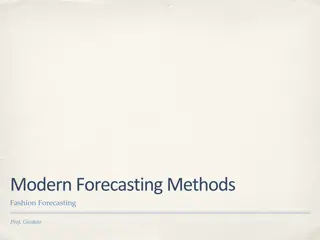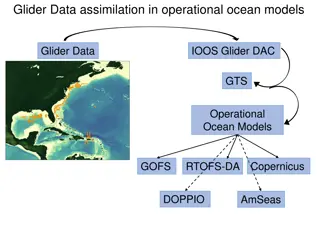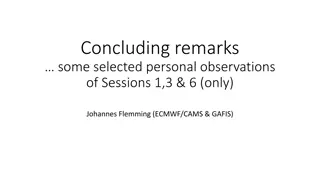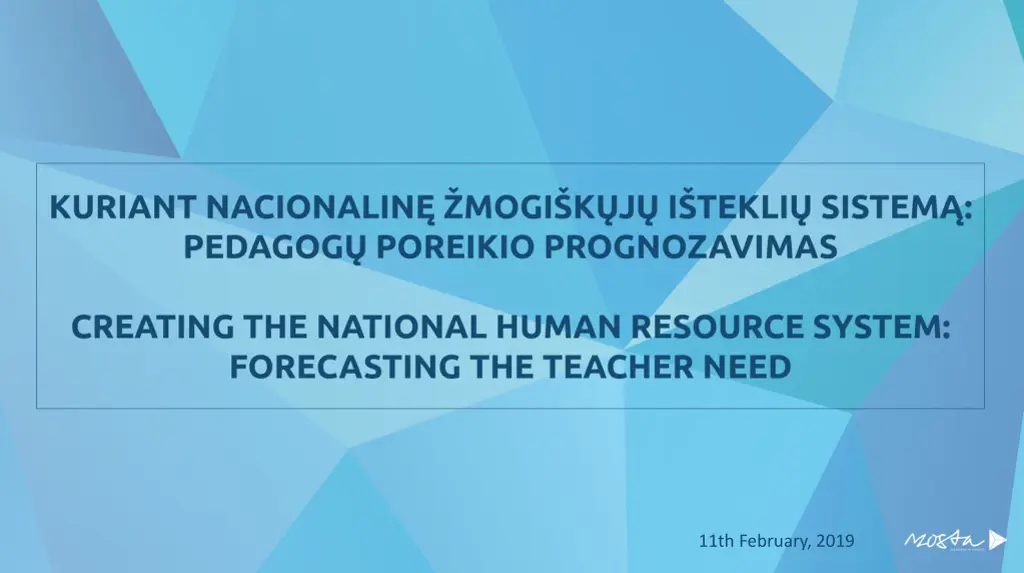
Improving Teacher Workforce Balance in Lithuania: Project Design and Stakeholder System
"Explore a strategic project in Lithuania aimed at balancing teacher workforce demand and supply, utilizing data-driven models and stakeholder engagement. Learn about the criteria and specialized scopes to address teacher shortages effectively." (277 characters)
Download Presentation

Please find below an Image/Link to download the presentation.
The content on the website is provided AS IS for your information and personal use only. It may not be sold, licensed, or shared on other websites without obtaining consent from the author. If you encounter any issues during the download, it is possible that the publisher has removed the file from their server.
You are allowed to download the files provided on this website for personal or commercial use, subject to the condition that they are used lawfully. All files are the property of their respective owners.
The content on the website is provided AS IS for your information and personal use only. It may not be sold, licensed, or shared on other websites without obtaining consent from the author.
E N D
Presentation Transcript
PROJECT DESIGN To improve the balance between the number of students enrolled into initial teacher training programmes and the actual need for teachers at schoolsin Lithuania. Aim 1. Short-term (1 year) and mid-term (4 year) forecasts on new teacher demand. 2. Recommendations on student admission to ITT programmes and other recommendations related to balancing the oversupply and shortage in the teacher workforce. Outputs Model creation - MOSTA project The Implementation of Skilled Labor Supply Analysis and Monitoring System , European Social Fund. Implementation Technical assistance - Structural Reform Support Service (SRSS), European Commission. 2
SYSTEM STAKEHOLDERS Primary data sources Teachers Register Pupils Register Student Register Regularly updated database Education Management Information System (EMIS) Planning model owner Research and Higher Education Monitoring and Analysis Centre (MOSTA) Research and Higher Education Monitoring and Analysis Centre (MOSTA) Analysis and recommendations Expert Group Policy makers Municipalities, schools Users HEIs Society 3
MODEL CRITERIA Data driven Model uses data from the register of teachers and tax authorities as an input and provides quantitative projections or forecasts. The model allows analytics test scenarios by changing model inputs. Flexible The model is updated annually and requires as little human-driven data mining as possible. Automated The model allows flexible inputs that reflect changes in teacher training system and in general education. Relevant Model results are used to provide recommendations for changes in policy. Applicable The framework, input/output indicators and modelling steps are open and transparent to a wider society. Open Detailed The model results are provided by agreed level of detail. 4
MODEL SCOPE: SPECIALISATIONS WEIGHTED UNIQUE SPECIALISATIONS IN THE MODEL UNITS SPECIALISATIONS NOT IN THE MODEL UNIT FTE FTE FTE FTE FTE FTE 10744 1133 1920 580 1102 665 Pre-school tutor Integrated subject teacher teaching hours Speech therapist Other art discipline teacher teaching hours Pre-primary (grade 0) class teacher Non-formal education teacher teaching hours Psychologist Profession teacher (vocational school) teaching hours Social educator Principal or other manager FTE Teacher for children with special needs Other pedagogical staff member FTE teaching hours teaching hours teaching hours teaching hours teaching hours teaching hours teaching hours teaching hours teaching hours teaching hours teaching hours teaching hours teaching hours teaching hours teaching hours teaching hours teaching hours teaching hours teaching hours teaching hours teaching hours teaching hours teaching hours 683 536 790 1368 340 657 339 703 252 975 908 1756 2861 2083 1704 2265 342 5664 17 1251 2982 1538 427 Biology teacher Artistic training teacher FTE Chemistry teacher Art teacher Assistant psychologist FTE Religion education or Ethics teacher Sports coach FTE Economics teacher Physics teacher Nature and Human Being teacher WEIGHTED UNIQUE 2017 Geography teacher Native language (other) teacher History teacher 9290 IT teacher Physical education teacher 16143 Lithuanian language teacher 55875 Mathematics teacher 46585 Music teacher 30442 Optional subject teacher Basics of Civil Education teacher Primary school (grade 1-4) teacher ALL TEACHERS AND STAFF TEACHERS AND STAFF NOT IN THE MODEL TEACHERS AND STAFF IN THE MODEL TEACHERS AND STAFF IN THE MODEL Subject for children with special needs teacher Technologies teacher Foreign language (English) teacher Working at PGV 2017 Teachers only Other post types Foreign language (Other) teacher Human Safety teacher 5
FORECASTING MODEL FRAMEWORK Expansion demand for changes in pupil number (ED) Substitution demand (retirement, death, resignation) (SUB) Teacher demand Total teacher demand by specialisation (index s) and forecast year (index t) Supply and demand connection PHASE 1 New teacher demand forecast (Y) by specialisation (s) and year (t) PHASE 2 Student admission (A) Total teacher supply by specialisation (s) and year (t) Teacher supply ITT STUDENTS (STS) Non-qualified teachers (NQ) Inactive teachers (INAC) University College 6
SCENARIO TESTING AND MODELING 3 different scenarios (baseline; scenario 1; scenario 2). Publicly available. 1. New scenario creation based on built-in assumptions. Publicly available. 2. Modeling of certain model elements as an input to the new teacher demand forecast. Publicly available. 3. New scenario and assumption creation. Available only for model creators. To be determined by the work/ expert group. 4. 7
PILOT PROJECT RESULTS AND AN INTERACTIVE TOOL ABOUT THE PROJECT, INTERIM DOCUMENTS, MEETING REPORTS AND OTHER https://mosta.lt/lt/apie-mosta/vykdomi-projektai/pedagogu-prognozavimas FINAL REPORT (ENGLISH) https://mosta.lt/images/pedagogai/2018-11-07-Forecasting-the-Teaching-Workforce-in-Lithuania.pdf INTERACTIVE TOOL: https://mosta.lt/images/pedagogai/MODEL_v3_public_v1_secured.xlsx 8

